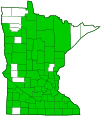Canadian clearweed
(Pilea pumila)
Conservation • Wetland • Description • Habitat • Ecology • Use • Distribution • Taxonomy
Conservation Status |
|
|||||||
| IUCN Red List | not listed |
|||||||
| NatureServe | N5 - Secure SNR - Unranked |
|||||||
| Minnesota | not listed |
|||||||
Wetland Indicator Status |
||||||||
| Great Plains | FAC - Facultative |
|||||||
| Midwest | FACW - Facultative wetland |
|||||||
| Northcentral & Northeast | FACW - Facultative wetland |
|||||||
Description |
||
Canadian clearweed is a 4″ to 20″ tall, erect, annual forb that rises on a single stem from fibrous, shallow, adventitious roots. It often forms large colonies. The stems are erect, light green grayish-green, or reddish-green, transparent, unbranched, smooth, and hairless. The are round in cross section. The leaves are opposite, thin, elliptic to broadly elliptic or egg-shaped, 1¼″ to 5″ long, and ⅜″ to 3½″ wide. They are on leaf stalks that are often 1″ long or longer. Each leaf is equal in size to the leaf on the opposite side of the stem. The leaf blade is broadly wedge-shaped or rounded at the base. It does not have ear-like lobes at the base. It is slightly transparent, most noticeably on the lower surface. The margins are coarsely toothed with sharp or rounded, forward-pointing teeth. The tooth at the tip is elongated. The upper surface is medium to dark green, shiny, and hairless. The lower surface is light green and hairless. There are three parallel main veins, the midvein and two lateral veins that arch toward the tip. The veins are conspicuously depressed on the upper surface, giving the leaf blade a quilted or wrinkled appearance. The leaves turn bright yellow in the fall. The inflorescence is a crowded or loose, ¼″ to 1¼″ long, branched, flat-topped cluster (cyme) rising from the upper leaf axils. The cyme is 55% to 70% as long as wide and shorter than the leaf stalk. It contains both male and female flowers. The flowers are less than ⅛″ long and about 1 ⁄32″ in diameter. Male flowers have no petals, 4 greenish-white sepals, and 4 stamens. Female flowers have no petals, 3 greenish-white sepals, and 1 style. The flowers are not fragrant. The fruit is a dry, tear-drop shaped, 1 ⁄32″ to 6 ⁄16″ long seed case (achene). It is green or greenish-yellow at maturity, sometimes with fine, purple lines. The purple lines, when present, are sometimes slightly raised. |
||
Height |
||
4″ to 20″ |
||
Flower Color |
||
Greenish-white |
||
Similar Species |
||
| Stinging nettle (Urtica dioica ssp. gracilis) is a much taller plant, up to 72″ in height. The stem and leaves have stinging hairs. | ||
Habitat |
||
Moist to wet. Woodlands, woodland margins, and streambanks. Full shade. In rich soil. |
||
Ecology |
||
Flowering |
||
July to September |
||
Pests and Diseases |
||
|
||
Use |
||
|
||
Distribution |
||||
|
Sources |
|||
| 3/20/2023 | ||||
Nativity |
||||
Native |
||||
Occurrence |
||||
Common |
||||
Taxonomy |
|||
Kingdom |
Plantae (green algae and land plants) |
||
Subkingdom |
Viridiplantae (green plants) |
||
Infrakingdom |
Streptophyta (land plants and green algae) |
||
Superdivision |
|||
| Division |
Tracheophyta (vascular plants) |
||
Subdivision |
Spermatophytina (seed plants) / Angiospermae (flowering plants) |
||
Class |
|||
Superorder |
Rosanae |
||
Order |
Rosales (roses, elms, figs, and allies) |
||
Family |
Urticaceae (nettle) |
||
Genus |
Pilea (clearweed) |
||
Subordinate Taxa |
|||
|
|||
Synonyms |
|||
Adicea pumila Urtica pumila Pilea pumila var. deamii Pilea pumila var. pumila |
|||
Common Names |
|||
Canada clearweed Canadian clearweed clearweed |
|||
Glossary
Achene
A dry, one-chambered, single-seeded seed capsule, formed from a single carpel, with the seed attached to the membranous outer layer (wall) only by the seed stalk; the wall, formed entirely from the wall of the superior ovary, does not split open at maturity, but relies on decay or predation to release the contents.
Adventitious roots
Roots originating on any part of the plant other than the usual underground root zone: the lower stem above ground, the branches, or the leaves.
Axil
The upper angle where the leaf stalk meets the stem.
Cyme
A branched, flat-topped or convex flower cluster in which the terminal flower opens first and the outermost flowers open last.
Sepal
An outer floral leaf, usually green but sometimes colored, at the base of a flower.
Visitor Photos |
|||||
Share your photo of this plant. |
|||||
| This button not working for you? Simply email us at info@MinnesotaSeasons.com. Attach one or more photos and, if you like, a caption. |
|||||
|
|||||
MinnesotaSeasons.com Photos |
|||||
|
|||||

Visitor Photos |
|||||
Share your photo of this plant. |
|||||
| This button not working for you? Simply email us at info@MinnesotaSeasons.com. Attach one or more photos and, if you like, a caption. |
|||||
|
|||||
MinnesotaSeasons.com Photos |
|||||
|
|||||

Visitor Videos |
|||
Share your video of this plant. |
|||
| This button not working for you? Simply email us at info@MinnesotaSeasons.com. Attach a video, a YouTube link, or a cloud storage link. |
|||
Other Videos |
|||
Identifying and Removing Clearweed |
|||
About
Uploaded on Jan 14, 2010 Dave shows you how to identify and remove clearweed. |
|||

Visitor Sightings |
|||||
Report a sighting of this plant. |
|||||
| This button not working for you? Simply email us at info@MinnesotaSeasons.com. Be sure to include a location. |
|||||
|
|||||
MinnesotaSeasons.com Sightings |
|||||

|
Created: Last Updated: © MinnesotaSeasons.com. All rights reserved. |
